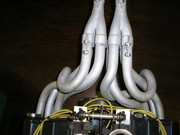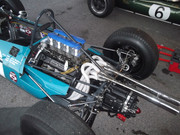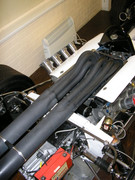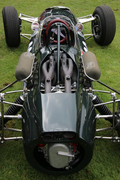The early Climax FWMV engines had 2-plane crankshafts and a convoluted exhaust system that ended in two megaphones over the gearbox. This was apparently to allow pipes from cylinders in opposite banks to be linked to the benefit of gas extraction from the cylinders. In 1963, Climax produced a single-plane crankshaft, initially at the request of Ferguson who were planning to fit a V8 in their front-engined P99. The first single-plane crank appeared during practice for the Belgian Grand Prix in Bonnier's Cooper. Its first race appearance was the Dutch Grand Prix in Gurney's Brabham. I have never seen a photograph of the rear of Bonnier's car but slender, low-level megaphones. Apparently the single-plane crank made the linking of exhausts unnecessary.
Climax found that the expected vibration problems with a single-plane crank did not materialise and we are told, by Walter Hassan among others. that all new engines from autumn 1963 onwards had single plane cranks. Many early engines were converted to single-plane cranks. during 1964 and 65, Team Lotus cars often had low-level exhaust and it was common then and now to refer to those as having single-plane cranks and the high level exhausts as 2-plane cranks. Apart from those few 1963 races in Gurney's car and the rare and brief appearances of the 32-valve engine in 1965, I can't recall seeing a Brabham-FWMV with low level exhausts and never a Cooper so fitted.
I know that none of these three teams were flush with money at the time but is it really possible that they continued to use two-plane cranks to the end of 1965 - or did they continue with high-level exhausts even when they were no longer necessary? Simon Hadfield once told me that FWMVs in historic racing all use single plane cranks and those that I have seen don't link the exhausts. Were they doing the same in 64-65? If so, descriptions such as "Clarks car had a single-plane crank while Spence had an old 2-plane crank" must be doubtful.
My tired old brain aches even more when it comes to BRM. They also started with 2-plane crankshafts and changed to single plane in 1963. It appears that they adopted linked exhausts at the same time, although the linkage was underneath the engine, so not normally visible. Is it really true that Climax dropped linked exhausts when they changed to single plane cranks while BRM changed to linked exhausts at the same time?
To make matters worse, I believe that some H16 engines had linked exhausts on the bottom bank but not the top!































